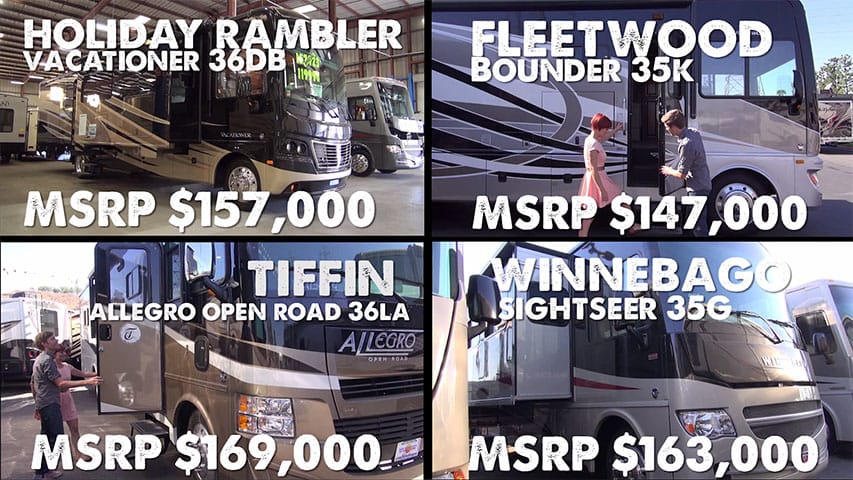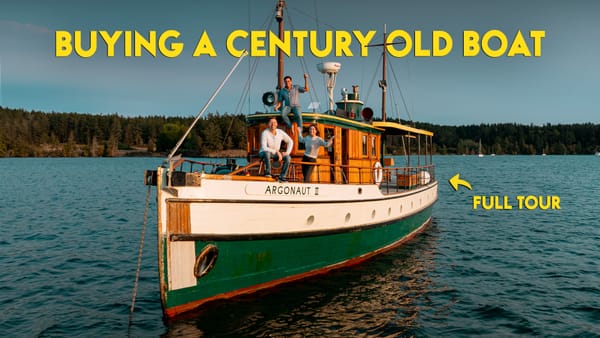RV Shopper Series – Midsize Class A Gas

If you’re looking for a motorhome that’s a BIG step up in quality from the entry level gas RV, but not as expensive as a diesel RV, then a midsize Class A Gas RV may be in your future!
In this RV Shopper Series video we bring you along as we inspect what we’ve found to be the best sellers, the new-to-the-market and the most popular midsize gas motorhomes. We walk through each coach and point out our top three likes and dislikes, and while we can’t cover every detail about each of these RVs, we can share a few of our personal thoughts and concerns about them. We hope by sharing our shopping style it will help with your own motorhome search.
If you haven’t seen The Shady Truth About Buying An RV, check it out before you start any wheeling and dealing.
There are several other RVs in this segment including the Thor Miramar, Newmar Bay Star, and the Forest River Georgetown XL just to list a few. Since we’re only comparing four motorhomes in this shopper series we feel these are a good representation of the midsize class A gas RV. Here are the results from our personal shopping experience listed in order of our favorite to least favorite:
- Holiday Rambler Vacationer 36DBT – 3 thumbs up
- Fleetwood Bounder 35K- 3 thumbs up
- Winnebago Sightseer 35G – 2 thumbs up
- Tiffin Allegro Open Road 36LA- 2 thumbs up

Who is this RV made for?
We think the 35′ midsize Gas RV is perfect for the person that wants a quality build but doesn’t need or want diesel power. The RVs we’ve reviewed are a big step above the entry level gas RVs, but they’re not the top-of the-line gas RVs (if you want to go a step further in luxury you might consider the Newmar Canyon Star, the Winnebago Adventurer, or the Fleetwood Southwind). Many of these RVs will sleep 4 or more and all offer 1.5 or 2 bath options. The build quality should should stand up to full-time use if you plan to sell everything and hit the road for good.
How much does this RV cost?
It’s difficult to translate the MSRP into the actual “Street Price” you might expect to pay. I’ve seen the Bounder and the Sightseer listed on a “fire sale” for around $100k on MHSRV and La Mesa RV. In general you might plan on getting 20% – 30% off MSRP depending on location, time of year, options and supply. All of these brands offer pretty similar quality so we personally feel you can’t go wrong with any of them, so if you see a great deal on the perfect floorplan then go for it!
What to look for when shopping for this type of RV.
- Residential Fridge – Some of these RVs offer a residential fridge, for us it’s a catch 22: More storage space with zero maintenance but it sucks up power like the Cookie Monster inhales cookies! Personally I prefer the residential fridge but if you plan on doing any wild camping we suggest you have a minimum of 600AH of battery and 600 watts of solar power on the roof.
- Inverter and Batteries – Some of these models offer a 2000 watt puresine wave inverter which is huge if you plan on wild camping a lot. Some offer four 6 volt batteries producing around 400 amp hours of battery power. None will offer sufficient power for boondocking with a residential fridge unless you plan on installing solar or running the generator.
- Tank Capacities – Make sure you understand the fresh, grey and black tank carrying capacities of each RV, it will vary greatly between manufacturers, models and floor plans.
- Insulation – In general these RVs are going to have better insulation to protect from the elements, but they’re still not considered “4 season” coaches so when you’re camping in freezing temps you will need to be cautious of bursting pipes. On the other end of the spectrum camping in 100 degree weather means those A/C units will be running non-stop!
- General Build quality – Take note of the quality of the things you’ll use daily such as windows, storage bays, entry door, cabinets, bed, bathroom, faucets, sinks, fridge, seating comfort, A/C, heater, awning, etc. Remember some things can be swapped easily afterwards while other items like window shades may cost a small fortune to replace.
- GVWR, GCVWR, GVWR, OCCC – All these acronyms add up to provide EXTREMELY valuable information about your RV: how much stuff you can carry; how much towing capacity you have; how much water you can load into your tank. Make sure you ask for this info on each RV you consider purchasing.
That’s it for now, if you have questions, comments or personal experience with one of these midsize class A gas RVs, please share in the comment box below. For the RV shopper the search can be exciting and exhausting at the same time but we hope this RV shopper series helps, even if it’s just a little.
Disclaimer – We’re generalizing with a lot of this information, but by sharing our experiences we hope it helps others target which RV might be right for their needs. These are all our opinions so take ‘em for what they’re worth and then do more research! The different RV dealerships didn’t compensate us nor are we affiliated in any way, but we are thankful they let us tromp around and film inside their RV’s. None of the RV manufactures featured here compensated us either. All opinions expressed are our own and based on our RV’ing experience. At the time of filming we traveled in a Fleetwood Excursion.




